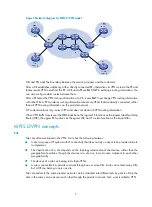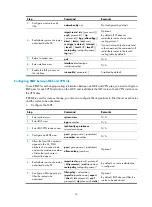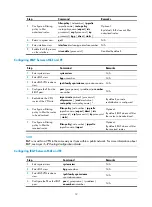
9
Step Command
Remarks
4.
Configure a description for
the VPN instance.
description
text
Optional
Associating a VPN instance with an interface
After VPN instances are configured, you must associate the VPN instances with the interfaces connecting
the VPN sites, and:
•
In an MPLS L3VPN application, you must also associate the VPN instances with the interfaces
connecting the PEs.
•
In a tunneling application, you must also associate the VPN instances with the tunnel interfaces
connecting the peer MCE devices or CE devices.
You can associate a management Ethernet interface on the switch with a VPN instance so that the IP
address of the interface participates in the route calculation of only the specified VPN instance.
To associate a Layer 3 aggregate interface with a VPN instance, you must associate all the member ports
of the aggregate interface with the VPN instance.
Executing the
ip binding vpn-instance
command on an interface deletes the IP address of that interface.
You must reconfigure the IP address of the interface after executing the command.
To associate a VPN instance with an interface:
Step Command
Remarks
1.
Enter system view.
system-view
N/A
2.
Enter interface view.
interface
interface-type
interface-number
N/A
3.
Associate the current interface
with the VPN instance.
ip binding vpn-instance
vpn-instance-name
By default, no VPN instance is
associated with the interface.
Configuring route-related attributes of a VPN instance
The control process of VPN route advertisement is as follows:
•
When a VPN route learned from a site gets redistributed into BGP, BGP associates it with a route
target extended community attribute list, which is usually the export target attribute of the VPN
instance associated with the site.
•
The VPN instance determines which routes it can accept and redistribute according to the
import-extcommunity
in the route target.
•
The VPN instance determines how to change the route targets attributes for routes to be advertised
according to the
export-extcommunity
in the route target.
IMPORTANT:
•
Only when BGP runs between the MCE and PE can the route target attribute be advertised to the PE
along with the routing information. In other cases, configuring this attribute makes no sense.
•
Before associating a routing policy with a VPN instance, you must first create the routing policy.
Otherwise, the default routing policy is used.
To configure route related attributes of a VPN instance:






























